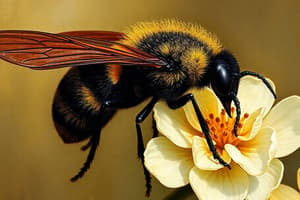Podcast
Questions and Answers
Se pueden utilizar barreras físicas como pantallas de malla fina o cubiertas de fila para prevenir la infestación de trips.
Se pueden utilizar barreras físicas como pantallas de malla fina o cubiertas de fila para prevenir la infestación de trips.
True (A)
El uso de jabón insecticida y aceite hortícola puede afectar negativamente a los insectos benéficos.
El uso de jabón insecticida y aceite hortícola puede afectar negativamente a los insectos benéficos.
True (A)
Los parasitoides naturales como la avispa Thripobius javae se utilizan comúnmente en el control biológico de trips.
Los parasitoides naturales como la avispa Thripobius javae se utilizan comúnmente en el control biológico de trips.
True (A)
El control químico es el método de control más efectivo contra los trips.
El control químico es el método de control más efectivo contra los trips.
El manejo integrado de plagas (IPM) implica la combinación de métodos de control cultural, biológico y químico.
El manejo integrado de plagas (IPM) implica la combinación de métodos de control cultural, biológico y químico.
La temperatura óptima para evitar la infestación de trips es de 15-20°C.
La temperatura óptima para evitar la infestación de trips es de 15-20°C.
El uso de fungicidas entomopatógenos como Beauveria bassiana es una forma de control biológico de trips.
El uso de fungicidas entomopatógenos como Beauveria bassiana es una forma de control biológico de trips.
El control cultural es el método de control más caro contra los trips.
El control cultural es el método de control más caro contra los trips.
Los trips pueden desarrollar resistencia a los insecticidas como los piretroides y neonicotinoides.
Los trips pueden desarrollar resistencia a los insecticidas como los piretroides y neonicotinoides.
La supervisión regular de poblaciones de trips es fundamental para ajustar las estrategias de control.
La supervisión regular de poblaciones de trips es fundamental para ajustar las estrategias de control.
Flashcards are hidden until you start studying
Study Notes
Control Methods for Frankliniella occidentalis (Western Flower Thrips)
Cultural Control
- Modify growing conditions to prevent thrips infestation:
- Maintain optimal temperatures (20-25°C) and humidity
- Ensure good air circulation and reduce humidity
- Avoid overwatering and fertilization
- Use physical barriers:
- Fine-mesh screens or row covers to prevent thrips from reaching plants
- Individual plant covers or bags to protect high-value crops
Biological Control
- Introduce natural predators and parasites:
- Lady beetles, lacewings, and parasitic wasps (e.g., Thripobius javae)
- Predatory mites (e.g., Neoseiulus cucumeris) and spiders
- Use entomopathogenic fungi:
- Beauveria bassiana and Metarhizium anisopliae to infect and kill thrips
Chemical Control
- Insecticidal soap and horticultural oil:
- Effective against thrips, but may require repeated applications
- May not provide long-term control or affect other beneficial insects
- Insecticides:
- Pyrethroids, neonicotinoids, and spinosyns can be effective, but may:
- Develop resistance in thrips populations
- Have negative impacts on beneficial insects and the environment
- Pyrethroids, neonicotinoids, and spinosyns can be effective, but may:
- Apply chemicals carefully:
- Follow label instructions and take necessary precautions to minimize harm to non-target organisms
Integrated Pest Management (IPM)
- Combine multiple control methods:
- Cultural, biological, and chemical controls to manage thrips populations
- Monitor thrips populations regularly to adjust control strategies as needed
- Develop a comprehensive IPM plan:
- Consider crop rotation, sanitation, and monitoring for thrips and other pests
- Involve multiple stakeholders, including farmers, researchers, and extension agents
Studying That Suits You
Use AI to generate personalized quizzes and flashcards to suit your learning preferences.




